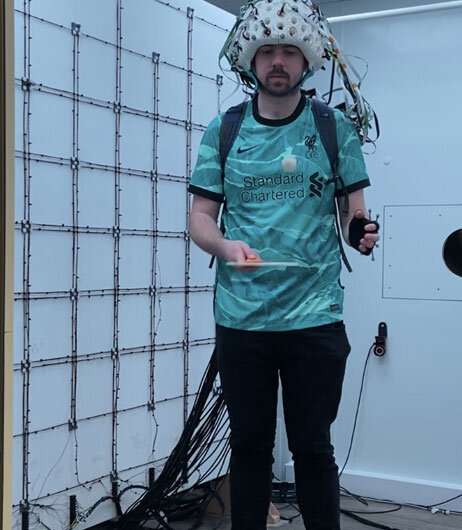Brain imaging is on the move with wearable scanning development

New research has demonstrated, for the first time, that a wearable brain scanner can measure brain function while people are standing and walking around. This breakthrough could help better understand and diagnose a range of neurological problems that affect movement, including Parkinson’s Disease, stroke and concussion.
To enable this novel technology, researchers from the University of Nottingham’s School of Physics have developed a new design of magnetic field control system. This allows a much greater degree of subject movement than has ever been possible previously. The results have been published in NeuroImage.
The unique wearable brain scanner system uses small LEGO-brick-sized sensors—called optically pumped magnetometers (OPMs)—to measure magnetic fields generated by cellular activity in the brain—a technique called Magnetoencephalography, or MEG. These sensors are incorporated into a lightweight helmet. The unique design means the system can be adapted to fit anyone, from newborns to adults, and sensors can be placed much closer to the head, dramatically enhancing data quality. This is a step change from conventional brain scanners that are large and fixed and require the patient to stay very still during scanning.
However, OPMs must operate at precisely zero magnetic field to become sensitive enough to measure brain signals, this means they must be operated inside a magnetically shielded room (MSR). This room must contain additional equipment that allows precise control of magnetic fields at a level 50,000 times smaller than the Earth’s magnetic field. Existing solutions to this problem used complex wire patterns to generate cancelation fields over small, fixed regions. This allowed people to move their heads while seated, but was unable to allow ambulatory movement.
The Nottingham team have now designed a “matrix coil” system formed from multiple simple square coils. The coil currents can be reconfigured in real time to compensate magnetic fields over a moving region that can be flexibly placed within the coils, giving much greater scope for people to move during a scan.
By using the matrix coils to allow greater movement
Professor Matt Brookes leads MEG research in Nottingham and said, “Just five years ago, the idea of acquiring high resolution images of human brain electrophysiology while people walk around a room would have seemed like something from science fiction. The matrix coil has made this a reality. The applications span a huge area, from basic neuroscientific questions like how do young children learn to walk, to clinical challenges like why are older people prone to falling. It’s incredible to think how far this technology has come, and even more incredible to imagine where it’s going.”
The University launched the spin-out company Cerca Magnetics in 2020 to bring OPM-MEG research systems to the market. The wearable system has been installed in a number of research institutions across the globe, including Young Epilepsy’s Health and Research Center in the U.K. The team are currently working towards gaining clinical approval of the Cerca System to bring it closer to being used in clinical settings.
Niall adds, “We are excited to work with Cerca to incorporate this new coil design into the commercial systems and to see what new studies will be enabled by our work.”
More information:
Niall Holmes et al, Enabling ambulatory movement in wearable magnetoencephalography with matrix coil active magnetic shielding, NeuroImage (2023). DOI: 10.1016/j.neuroimage.2023.120157
Journal information:
NeuroImage
Source: Read Full Article



